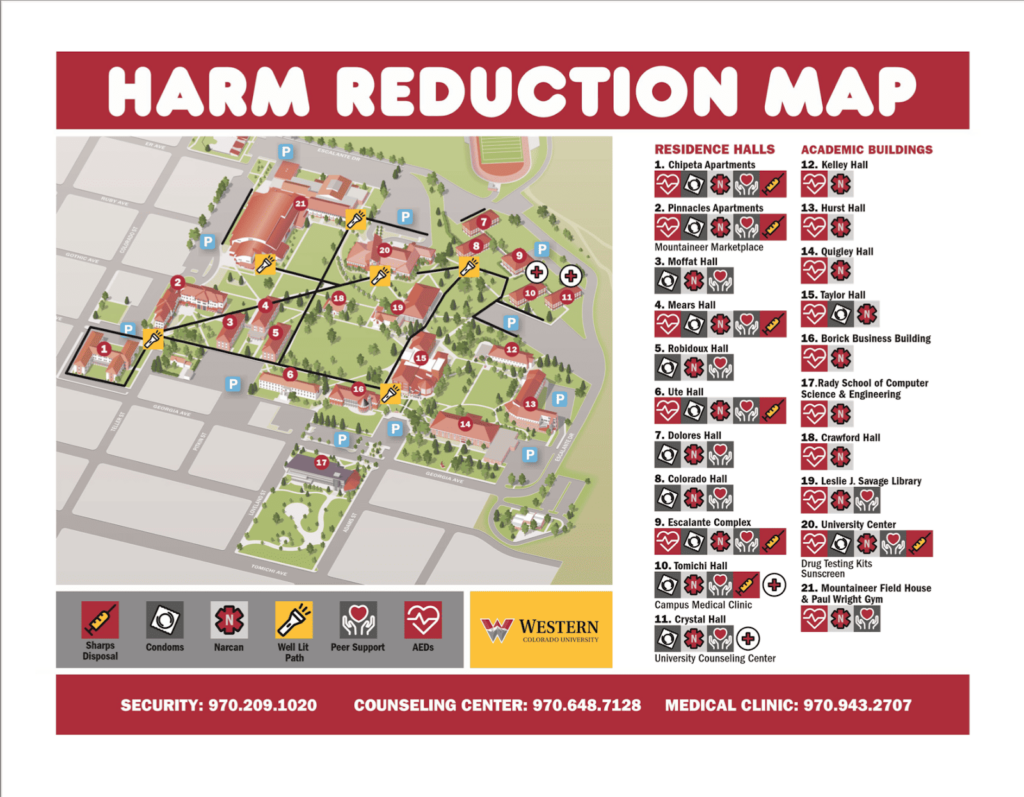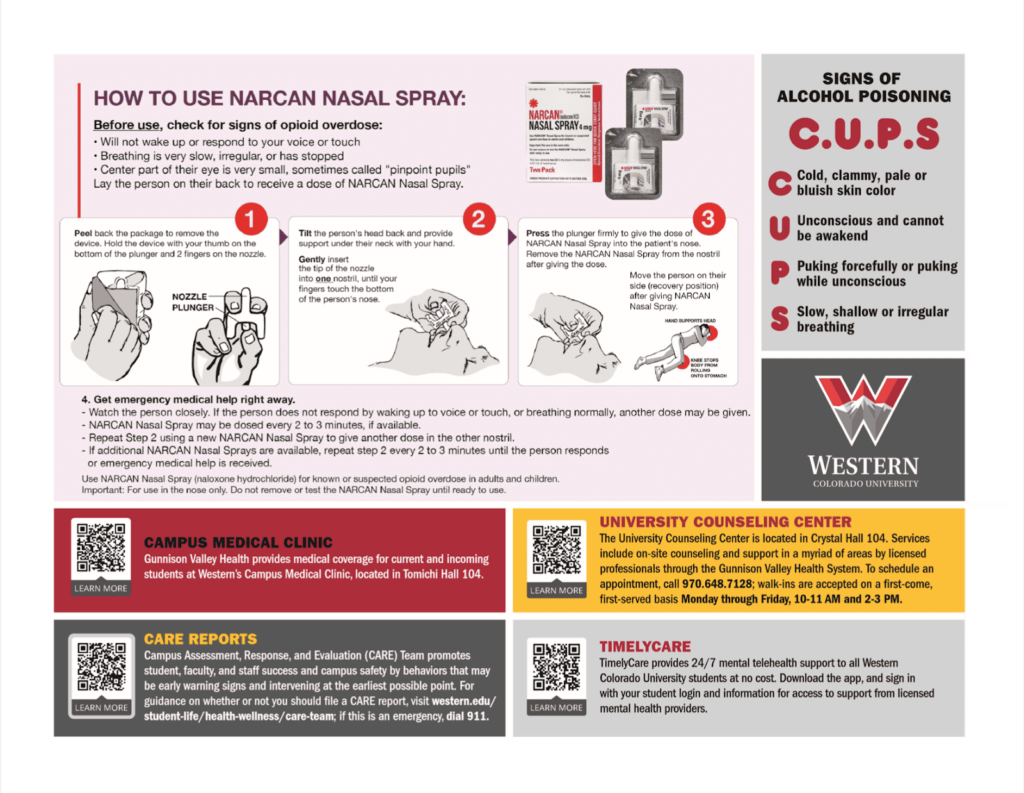By Kira Córdova
Associate director of Community Wellness McKenzie Mathewson and Western’s Peer Health Educators balance policy and realism, pushing for harm reduction on campus to protect students.

McKenzie Mathewson models some hard earned self-care.
What is harm reduction?
“We know that prevention is needed, but it doesn’t always work, and so if folks are going to do things that other folks would prefer that they didn’t do, we want to help them find a way to do it safely.”
That’s how Western’s associate director of Community Wellness McKenzie Mathewson defines harm reduction, a concept picking up steam across the US.
According to an article from Psychology Today, harm reduction is “an umbrella term that covers a wide range of health and social concerns,” including everything from needle exchange services to free condoms and dental dams.
“Harm reduction is a practical set of strategies and interventions aimed at reducing negative consequences and improving quality of life,” adds the piece.
Many people associate harm reduction with substance use, but it encompasses anything that can reduce harm inherent to any number of activities — and help keep people safe.
Speaking to whether she’s encountered resistance implementing harm reduction at Western, Mathewson explains, “I’ve been fortunate in that I haven’t. Campus has been really open, and I think that harm reduction works when you can highlight the successes and the research that shows that it keeps people safer.”
“A lot of times folks hear harm reduction, and they get a little nervous,” says McKenzie, “But wearing a seat belt is harm reduction. Putting on sunscreen is harm reduction. Wearing a helmet is harm reduction. Having a [designated driver] when you go out and drink is harm reduction. All of that is important, and we’ve been fortunate that we have a community that really wants people to be safe.”
Sounds vague? Absolutely! The great part about this open definition is that it gives the community wellness team leeway to hop in and keep students safe, which can take many forms.
What does harm reduction look like at Western?
According to the Health and Wellness page on Western’s website, the Department of Residence Life and Community Wellness combines preventative education and harm reduction initiatives to help students in areas including:
- Mental Health and Wellness
- Substance Use
- Sexual Health and Healthy Relationships
- Suicide Prevention
- Stress and Anxiety
Mathewson says the biggest harm reduction initiative the Community Wellness team has instituted is the harm reduction map, a resource that compiles information on the various programs on campus available to students.
“[It’s] a map of campus that highlights where we have sharps disposal, condoms, Narcan, well lit paths, peer support, all that good stuff,” Mathewson expands.
Students can find the map in the new student guide or pick up a copy in the Residence Life office in the University Center.


Speaking to other significant initiatives, she highlights Narcan, an opioid overdose reversal agent that’s become especially relevant in past years with the arrival of the fentanyl epidemic.
Overdosing on fentanyl, a synthetic opioid now often found laced in other substances, is the leading cause of death for Americans 18 to 45.
“[We’ve embraced] having Narcan across campus at each of our AED locations. We have these things called ONEBoxes which look like a tackle box on the wall, but when you open it, it gives you a step-by-step training of how to administer Narcan,” Mathewson explains.
“Also, [we’ve added] sharps containers on campus because we have a lot of diabetic students and community members who come to campus, and so if we can protect our custodial team from getting accidentally poked by [a needle] because it wasn’t disposed of properly, that’s incredible,” she adds.
Sharps containers also give students and community members who may participate in intravenous drug use a place to safely dispose of needles (as well as those who dabble in tattooing and piercing).
For students questioning their substance use habits, Mathewson adds that three professionals on campus, herself, Pinnacles and Chipeta residence director (RD) Enrique Rosario, and Escalante Complex RD Culum Wash, are all expert training in SBIRT, Substance Brief Intervention Referral to Treatment.
“It’s just what it sounds like: a brief screening where students can identify some of their habits and how frequently they might engage in something for them to determine if they want to change their habits [and what resources they have],” she expands.
Western also recently sent 12 staff members, including Mathewson, to ASIST, or Applied Suicide Intervention Skills Training.
“So there are now twelve of us on campus who are very, very comfortable in talking to students who might be expressing some suicidal ideaology. And that’s not to say that there aren’t more people [on campus who can intervene]. These are just 12 people who went through a 16 hour intensive training, really highlighting how to get someone connected to the care they might need.”
Safety over discipline
Harm reduction starts early; In addition to the Get Inclusive modules required for freshman prior to orientation, which clearly explains Western’s policies and highlights harm reduction resources incoming students will have on campus, Mathewson facilitated an event called Welcome to the Party for all incoming freshmen to emphasize that, while Western will uphold its policies, at the end of the day, the focus is on student safety:
“I explained all of the policies and noted that Western is a federal institution, so we will uphold these things, but really went into depth on the amnesty policy on the resources that are available and the resources in town. We gave out 135 doses of Narcan that night and trained everyone in that room and gave a demonstration of how to administer [Narcan]. We also let students wear some drunk goggles, so that they knew how their vision would be affected if they were choosing to be under the influence of anything while also handing out Safe Ride lanyards.”
Safe Ride is a local resource offering free transportation in and around Gunnison on Wednesdays, Fridays, and Saturdays, no questions asked. The organization also promotes alcohol education and safety in the Gunnison Valley.
Western’s amnesty policy says that students will face less severe sanctions for policy violations (like underage drinking or using marijuana) and won’t face legal action if they seek help for themselves or a friend who may be in danger from improper or overuse.
“Again, we really emphasize that we follow all laws here, and we want you to be safe and that it is much better to call for help than to let someone’s college career go down the drain because you were afraid you were going to get in trouble. That’s why we have an amnesty policy to protect people because we want to see you [live to] graduate,” Mathewson says.
Introducing the Peer Health Educators
One harm reduction initiative on campus has a face. Actually, it has three. Ryan Smith, Izzy Stollsteimer, and Holly Hunter are this year’s Peer Health Educators.
“The peer health educators are exactly what they sound like: peers who care about their fellow students and want to support them. We know that sometimes marching into my office or even [Dean] Gary’s office can be a little bit intimidating, especially if you want to ask for something like a COVID test or a condom, or even Narcan, because there is that kind of perceived stigma that if you engage in harm reduction, you might be doing something you’re not supposed to when, in all [reality], we just want you to be safe,” relays Mathewson.
“So, the peer health educators are really championing stigma reduction, [saying] it’s OK if you need something [and] please don’t hesitate to ask us for it.”
Advocating for yourself — and the campus community
Mathewson says that one of her main goals is to let students know that there are many available resources for them to use.
“I’d want them to know it’s better to be safe. Just ask for support and resources. You can’t really do something wrong unless you’re knowing that you’re engaging in something risky and then just letting it just happen. You’re not going to ride your bike down the biggest mountain in Crested Butte without a helmet on, so why would you engage in anything else when you knew that there was something that could help protect you?”
Despite making huge strides, Mathewson isn’t resting on her laurels when it concerns harm reduction on campus.
Currently, she’s aiming to get EpiPens on campus to help students with anaphylactic allergies, and she says, if she had all the money in the world, she’d expand Safe Ride into a 24/7 service (currently, it runs Wednesdays, Fridays, and Saturdays).
Got an idea for how to make campus safer? She’d love to hear it! You can contact her at mmathewson@western.edu.
“If students have ideas of things that could be helpful, I am always so happy to make a student dream a reality.”
Resources for students and others in need
In crisis? Call 911 or the Colorado Crisis Services Hotline at 1-844-493 TALK (8255) or text TALK to 38255. The hotline has trained professionals available for free, immediate, and confidential help 24/7, 265 days a year.
The GVH emergency room is located at 711 N. Taylor St. and can page the Mental Health Emergency Professional on call.
The National Suicide Prevention Lifeline is 800-273 TALK (8255) (para Español: 888-628-9484).
TimelyCare TalkNow on-demand support service is available through the TimelyCare app. Students can log in and access the free service with their Western login.
Safe Ride runs Fridays, Saturdays, and Sundays and can be reached at 970-209-RIDE (7433)

